The Desert Northwest
Botanical Expedition to Southern Washington
October 2011
Page 4 - Big Lava Bed
|
First, though, I had one more important stop for the day before spending a whole lot of time looking for Arctostaphylos near Bingen. I headed west toward Willard and then on some forest roads to the Big Lava Bed. After passing Willard and “Mill A” (yes there's really a place called that) I was keeping my eyes peeled for Chrysolepis chrysophylla, which has been recorded from the area; also, Mike Lee of Colvos Creek Nursery says he saw one around there once. However, for most of the stretch of road passing through the area where it might be found, both sides had been very recently logged off leaving no trees close to the road. Of course I had my eyes open for interesting trees all the same, but I didn't spot anything. So I continued on toward the Big Lava Bed.
|
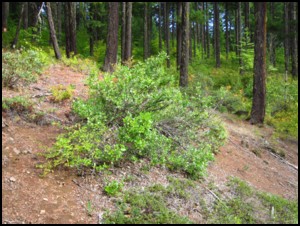
|
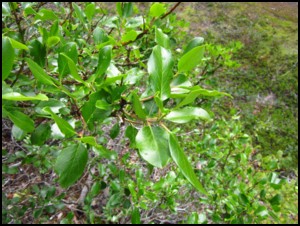
|
Finally a few miles in, I encountered one of the plants I really wanted to find on this trip, Garrya fremontii. Much more common in Oregon and northern California, this is probably just about its northern limit.
|
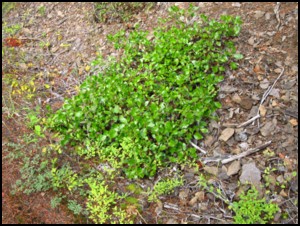
|
Here's one that appears to be getting a regular haircut from the roadside mower.
|
|
This turned out to be a great spot for Arctostaphylos as well, including these A. columbiana, which extended well back into the forest's shade.
|
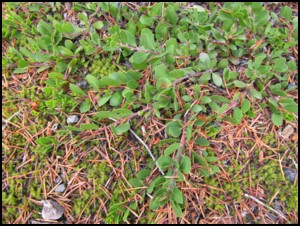
|
And some almost typical, but still perhaps a bit on the flat side, A. nevadensis.
|
|
And some very nice looking hybrids between the two, which were exciting to find. And another Penstemon (not pictured).
|

|
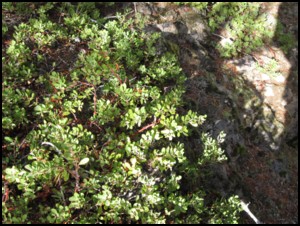
|
I continued farther up the road until I felt like it was time to turn around. Before returning though I thought I'd take a quick look at the lava to see what was growing on it. First I found this very nice Arctostaphylos columbiana x nevadensis pretty close to the road on the edge of the Big Lava Bed.
|
|
Most people in Washington don't even know we have a Big Lava Bed, associating this sort of thing with central Oregon – but we do indeed, and it's HUGE, and most of it looks a lot like this. One would not want to get lost here. Apparently compasses do not work on the lava as it affects their magnetism somehow; at least that is what I have heard.
|
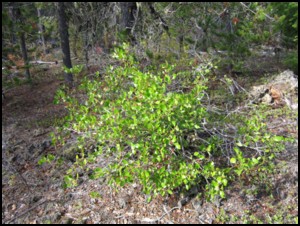
|
Here's Garrya fremontii again, this time growing contentedly right ON the lava. It is locally common here; apparently it gets enough light with the very open tree canopy resulting from the absence of any real soil on the lava.
|
|
On my way out I stopped for a couple more good hybrid Arctostaphylos, which I apparently didn't see on my way in for some reason (driving into the sun again?). So that area was pretty cool and well worth the trip.
|

|
It was now getting late in the afternoon, and I wanted to spend the remaining daylight hours looking around the White Salmon/Bingen area for Arctostaphylos patula. I also thought that if I was really lucky I might find a hybrid swarm of A. columbiana and A. patula somewhere in the area, since (according to records) they come within just a few miles of each other around here. First I checked the south side of Underwood Hill where A. columbiana has been recorded. There were plenty of them at first, on the west side of the hill; then they got really scarce as I approached White Salmon, entering an area that was intensely developed for agriculture, quite recently it seemed in some places.
|
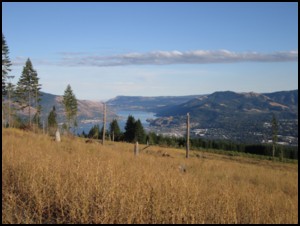
|
Great view but you have to wonder just how many interesting Arctostaphylos were growing here before the whole area was leveled off.
|

|

|
I stopped for a few scenic shots above White Salmon; that's the Columbia River looking east, and Mt. Hood.
|

|
So there was no luck to be had in the Underwood Mountain area, although one could spend a lot more time looking around the hills to the north. So then it was back to Bingen and the elusive Bingen Arctostaphylos patula. Although the record on which my search was based just says "Bingen"; I had, and continue to have, the idea that the plants were not found right in Bingen itself, but somewhere in the hills behind it (hence my binocular search at lunchtime). It would not make sense for them to occur at such a low altitude as Bingen, which is right on the Columbia River, when they are invariably (as far as I know, thus far) above 2,000' on the Oregon side of the River and above 1,300' in the Glenwood area. So I drove up to the hills following signs for Snowden Road, which looked like a nice through road that would lead somewhere, since there were so many signs announcing the direction to Snowden. It was there that I took this final shot of Mt. Adams.
|
|
Things were going well at first, though I did not spot any Arctostaphylos other than a few stray A. nevadensis. I also saw a sheriff's deputy pull over an ATV (all-terrain vehicle) which seem to be very popular in Klickitat County. I saw several people using them on county roads, though this is illegal. As I approached Snowden I noticed traffic diminish to almost nothing. Then a couple miles before Snowden the road turned to gravel and entered a thick forest (at this point I perhaps should have turned south and continued my search in the more open forests toward Bingen Mountain). Snowden turned out to be a four-way gravel crossroads with one single structure, a church converted into a residence. I guess someone had big dreams for a town there long ago. I forged my way through on some very bad unpaved roads until I reached Appleton (which was slightly more of a town, but hardly exciting) and found pavement again. Finally I returned to the Columbia River coming out in Lyle.
One could easily spend a lot more time searching this area for Arctostaphylos patula, as there are many more roads I didn't have time to drive on south towards Bingen Mountain and north towards Glenwood. But I decided it's not that high of a priority for me to spend hours looking for something that might not be there when I could easily find it somewhere else. It would be nice to know whether A. patula is there and what they look like but perhaps I'll leave the exploring in this area to someone else, at least for the time being.
I pulled into Horsethief Lake State Park just before dark. This was another nice campground on the Columbia River with some lower priced options than Maryhill, which I gladly took. Although it was not windy that night and I slept in comfort, I got rained on overnight and had to pack up a wet tent in the morning: a small price to pay for all the interesting plants I saw that day.
|
Page 5 - Mt. Hood Country >>
|